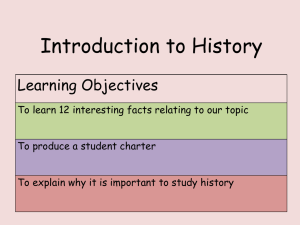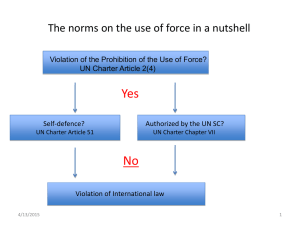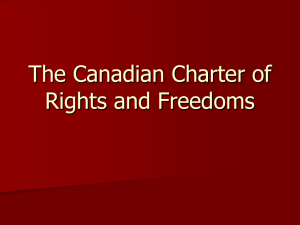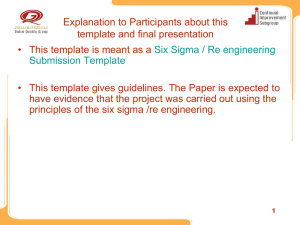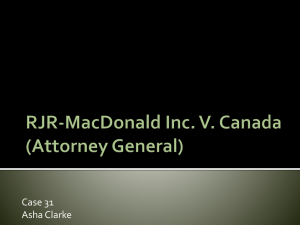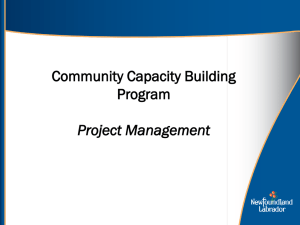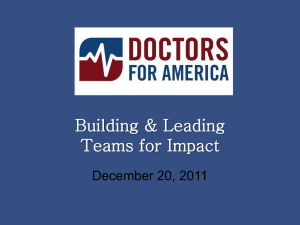“Recapturing the Ancient Path: The Original Instructions and the
advertisement
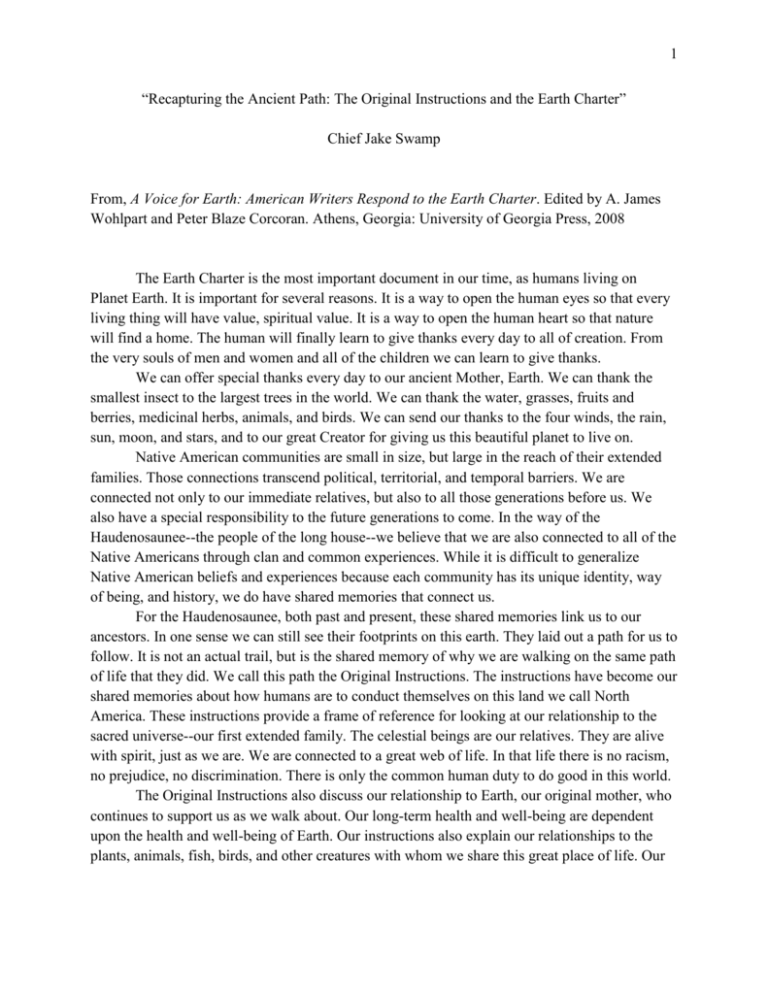
1 “Recapturing the Ancient Path: The Original Instructions and the Earth Charter” Chief Jake Swamp From, A Voice for Earth: American Writers Respond to the Earth Charter. Edited by A. James Wohlpart and Peter Blaze Corcoran. Athens, Georgia: University of Georgia Press, 2008 The Earth Charter is the most important document in our time, as humans living on Planet Earth. It is important for several reasons. It is a way to open the human eyes so that every living thing will have value, spiritual value. It is a way to open the human heart so that nature will find a home. The human will finally learn to give thanks every day to all of creation. From the very souls of men and women and all of the children we can learn to give thanks. We can offer special thanks every day to our ancient Mother, Earth. We can thank the smallest insect to the largest trees in the world. We can thank the water, grasses, fruits and berries, medicinal herbs, animals, and birds. We can send our thanks to the four winds, the rain, sun, moon, and stars, and to our great Creator for giving us this beautiful planet to live on. Native American communities are small in size, but large in the reach of their extended families. Those connections transcend political, territorial, and temporal barriers. We are connected not only to our immediate relatives, but also to all those generations before us. We also have a special responsibility to the future generations to come. In the way of the Haudenosaunee--the people of the long house--we believe that we are also connected to all of the Native Americans through clan and common experiences. While it is difficult to generalize Native American beliefs and experiences because each community has its unique identity, way of being, and history, we do have shared memories that connect us. For the Haudenosaunee, both past and present, these shared memories link us to our ancestors. In one sense we can still see their footprints on this earth. They laid out a path for us to follow. It is not an actual trail, but is the shared memory of why we are walking on the same path of life that they did. We call this path the Original Instructions. The instructions have become our shared memories about how humans are to conduct themselves on this land we call North America. These instructions provide a frame of reference for looking at our relationship to the sacred universe--our first extended family. The celestial beings are our relatives. They are alive with spirit, just as we are. We are connected to a great web of life. In that life there is no racism, no prejudice, no discrimination. There is only the common human duty to do good in this world. The Original Instructions also discuss our relationship to Earth, our original mother, who continues to support us as we walk about. Our long-term health and well-being are dependent upon the health and well-being of Earth. Our instructions also explain our relationships to the plants, animals, fish, birds, and other creatures with whom we share this great place of life. Our 2 shared memories of the past explain very clearly the relationship of people to one another. This web of life includes all living creatures, all peoples of the world. The path of the Original Instructions is echoed in the Earth Charter. In many ways, relationships between people, communities, cultures, and nations are predicated upon three simple values. First, we are to love each other as if we are members of one large, extended family. However, our concept of family is not to have a father in charge of the wife and children. Instead, the whole family is interconnected, dependent upon each member to fulfill its responsibilities to the well-being of the entire family. Like the Earth Charter says, we must “Strengthen families and ensure the safety and loving nurture of all family members.”1 Men and women are meant to be equal partners in this life. Elders represent the collective wisdom and experience of how to live on the land. Children are the best hope that the wisdom of the elders will continue. We must “Transmit to future generations values, traditions, and institutions that support the long-term flourishing of Earth’s human and ecological communities.”2 When humans realize that we are all related, we can come to one mind on matters, build healthy relationships, and live healthy lives. By loving one another, we can assure that future generations will be born into the world where reason replaces violence. Second, we are meant to share with one another. We look to the land as a huge bowl that provides life-giving foods and medicines so that human life can continue. We share one spoon to eat from that bowl. Each will take what he or she needs, not wasting what is left. Food and medicine do not belong to any one person. They were provided for the well-being of all. We should not be charging money for the gifts of nature, nor should we hoard the resources for our own. We need to respect the fact that food and medicine are sacred gifts of life, meant to be shared. As it says in the Earth Charter, we must “Accept that with the right to own, manage, and use natural resources comes the duty to prevent environmental harm and to protect the rights of people.”3 By sharing we teach cooperation and respect. By sharing, we “Care for the community of life with understanding, compassion, and love.”4 By sharing we all survive and human life can continue. Third, humans have been asked to respect the life’s breath that enters our bodies and allows us to exist. Life is a precious gift of time and we need to continually be thankful for what has been provided for us. All that is required for a happy and healthy life is already in front of us. As the Preamble of the Earth Charter says, a happy life “is primarily about being more, not having more.” We need to show respect for the sacred landscape in which we live. We need to “Respect Earth and life in all its diversity.”5 We need to respect ourselves and live in a peaceful and contributing way. Humans have a critical role in the well-being of the universe, and if we teach thoughts of love, sharing, and respect we can give the future generations not only hope, but also a way to fulfill that hope. With that as a background, I find it difficult to express the full nature of the changes that have been brought to our land and people in the last five centuries. Nearly all that we believe 3 about life has been exterminated, threatened, or suffers from lack of attention. It is a sad and troubling story to recall. I will try to share some of my personal thoughts about our shared memories of the contact between our peoples. Some of the memories are great moments of love, sharing, and respect. Others are not so good. Too often the memory of the darker times can create a prison for our emotions, as we have inherited much historical grief. Thinking of those values for human survival that I outlined, imagine what it must have been like the first time the Mohawk people heard the French guns blast their hot metal in 1609. French settlers, Samuel De Champlain, and some allied Native Americans attacked the Mohawks and after the smoke cleared, several lay dead, including three chiefs. The killing of the “men of peace” had a profound impact on the Haudenosaunee. It is not that killing did not exist before. In fact, if the Haudenosaunee have one of the greatest traditions of peace, it is not because everyone was full of love, sharing, and respect. Just the opposite. Our people were caught in a seemingly endless cycle of hatred, violence, and war. Our Great Law of Peace brought that strife to an end when people remembered the values of the Original Instructions. By keeping the peace in mind, treating everyone with respect, and making sure that justice prevails, we can have what we call the Good Mind. We do this when we “Recognize that peace is the wholeness created by right relationships with oneself, other persons, other cultures, other life, Earth, and the larger whole of which all are a part.”6 Perhaps it is human nature to forget such things, especially when times are good. It takes hard work to keep the peace. It takes a strong mind to overcome heartache and tragedy. My ancestors should have known better, but the lure of the fur trade and the desire for political and economic gain led them to take up arms against other Native American nations. The French, Dutch, and English were master manipulators. With their steel tomahawks and flint guns, the Haudenosaunee dominated native life in the Northeast. We forgot much of the Original Instructions and began to hack away at the sacred web of life. We settled for bright beads, shiny silver, and powerful weapons. However, it was a short-lived “victory.” Once the fur moved further to the west and the Europeans were no longer in such fierce competition, the Americans began to systematically remove the land from under the feet of my ancestors. We have all become aware of the dispossession of the Native Americans from their homelands. But think for a minute of what that dispossession must have done to the spirit of the people. Blood stained the ground where sacred ceremonies were once held. Great villages were turned into heaps of ash. Thousands of people were forced to flee into the uncertainty of the woods. Families became separated and lost. People were disconnected from the places where ancestors had practiced the Original Instructions. Their footprints were lost under wagon trails, train tracks, and sidewalks. The grandchildren became confused about where to go and what to do. The same old story could be told of the hundreds of native nations of this land. As the zeal of Manifest Destiny swept from East to West, the Native Americans became the sacrificial lamb in the quest for spiritual unity in American culture. The irony of that fact is part of our 4 collective memory. It still stings us to know that the romantic horizon of America’s past is littered with the bones of our ancestors. The basic denial of our inalienable rights seems hard to fathom when we hear of religious freedom and the right to life, liberty, and the pursuit of happiness. It is no wonder that some of our ancestors turned that oppression inward. A sad legacy of self-hatred was created, compounded of the experience of near extermination, displacement, and being sent off to schools that denied the validity of the ways of the ancestors. Our great grandparents were taught to hate themselves because of their way of life. Even those who did not go to the boarding schools have inherited the dysfunction from a generation that did not see any family love, did not experience any community sharing, and had no models or respect. As tragic as massacres were, perhaps the more serious damage was done to the survivors. The cultures, beliefs, and values that had sustained their communities for centuries were replaced with a plow, school bell, and Bible. For several generations the Native American survivors lived in virtual poverty, being considered wards of the federal government. Our grandparents were not even considered capable of taking care of themselves. The sacred relationships of the past were severed. Reservations and Indian agencies were operated like prisons. It is amazing that any of our traditions survived at all. Children were taken away from their families, many to be adopted by non-Indians. Despite all this, the stories of the past were shared in the quiet moments, away from the eyes and ears of the jailers. Even though teachers would wash out our parents’ mouths if they spoke their native languages, the people found a way to pass on their sacred memories about the old days--adding fresher memories of how their world had been turned upside down. People my age grew up in a very different world from that experienced by those elders. Many of us were in denial about who we were and what we wanted out of life. We eked out a living from a family farm, making baskets, or getting a job in town. Our people still suffered from racism, bias, and oppression. There was not much hope in the communities. The federal and state governments were still denying our political and human rights. Our lands were still under attack. We were reliving experience of our ancestors, but it was the twentieth century. Things did not change very much. The time has come to break the cycle of ignorance, shame, and oppression. Many Native American communities have begun to heal themselves. Many good people are working hard to reclaim the values of love, sharing, and respect. The spirit of the people is reemerging. Everywhere I go I can see a renewal taking place. I can hear more Native American words of healing, comfort, and unity. I can hear more songs floating in the wind. People are dancing and celebrating life. I try to do all I can to keep the values, beliefs, and way of life of my ancestors alive and thriving. The Earth Charter calls for us to “Affirm the right of indigenous peoples to their spirituality, knowledge, lands and resources” and upholds “the right of all, without discrimination, to a natural and social environment supportive of human dignity, bodily health, and spiritual well-being, with special attention to the rights of indigenous peoples . . . .”7 I have 5 traveled the world to spread the message of peace that we have inherited. I think it is profoundly important to continue the good dialogue started by our people many centuries ago when we would meet and polish the covenant chain of peace. We were really making relatives of each other. Some may call it a treaty making, but it was really making sure that we saw each other as relatives, just as the Original Instructions had told us. Yet, there is still an important step to be taken. We have focused much attention on ourselves. We need to expand the circle of healing and begin a dialogue with other races, cultures, and belief systems. We have to find ways to overcome our hurt feelings and anger at the “White man.” In order to be the kind of human beings envisioned at the time of creation, we need to overcome racial and cultural prejudices. The Earth Charter can open the human eyes and the human heart to make this dialogue possible. The Earth Charter cannot replace the Original Instructions for Native Americans. It can, however, provide a larger framework within which we can have a dialogue with others about our sacred values. This dialogue will help us learn to walk again on our ancient and sacred path. The Original Instructions can inform the Earth Charter, too, helping others understand their own path. Notes 1. Earth Charter, Subprinciple 11.c. 2. Earth Charter, Subprinciple 4.b. 3. Earth Charter, Subprinciple 2.a. 4. Earth Charter, Principle 2. 5. Earth Charter, Principle 1. 6. Earth Charter, Subprinciple 16.f. 7. Earth Charter, Subprinciple 12.b and Principle 12.
